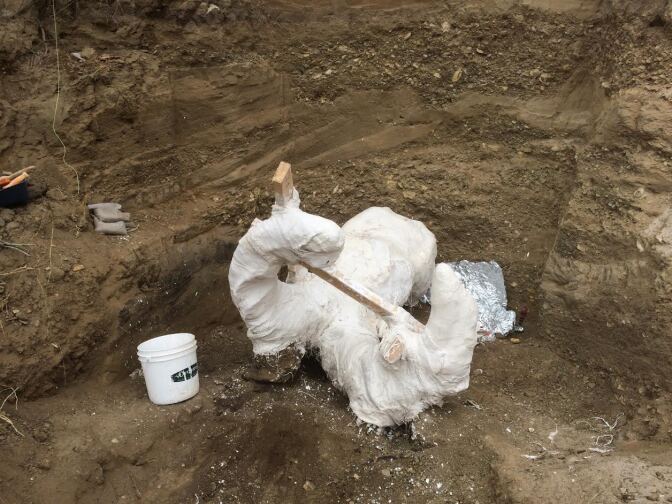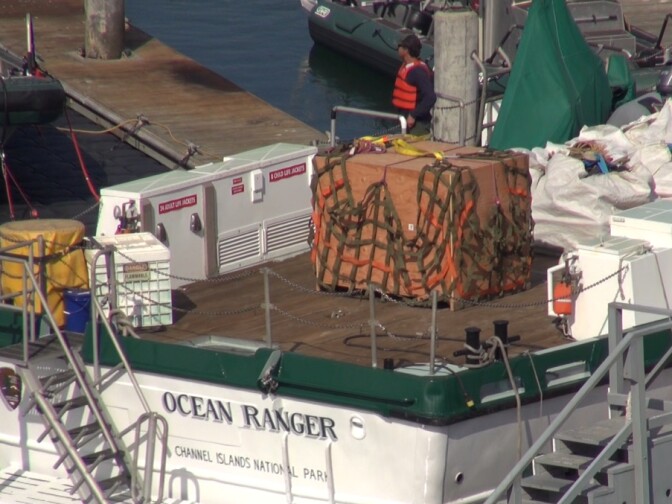Truth matters. Community matters. Your support makes both possible. LAist is one of the few places where news remains independent and free from political and corporate influence. Stand up for truth and for LAist. Make your year-end tax-deductible gift now.
This archival content was originally written for and published on KPCC.org. Keep in mind that links and images may no longer work — and references may be outdated.
Rare mammoth fossil returns from Channel Islands to mainland
Until this week, the fossil had been buried in the soil of Santa Rosa Island for 13,000 years. On Tuesday, one of the rarest and most remarkable mammoth skulls ever seen by modern humans was finally pulled from the earth, helicoptered to the island's pier and ferried across the waters separating the Channel Islands from the California mainland.
"It's quite a trip for a critter that had been sedentary for so long," says retired park service archaeologist Don Morris.
A fellow scientist had initially spotted the skull, noting a tusk protruding from the bank of a canyon on the island's west end.
"I looked at it and with my vast experience said, 'Let's dig another 20, 15 inches and we'll have this nice tusk and we can take it home today,'" Morris says. That was in 2014.
At the end of that dusty first day, Morris and his colleagues found the tusk was still inserted in the socket of what looked like a complete skull.
"We realized we were into something much more than we could handle on this short trip," he says. Morris and his team returned the following year and located the rest of the skull.
They worked with the USGS to perform radio carbon dating and conduct a soil analysis. The USGS also offered guidelines for digging, so the bank behind the specimen wouldn't collapse. "That was very much appreciated," Morris says. After a painstaking two-week excavation, the specimen is ready for analysis.
And that was the easy part of the job. Now, the hard work begins.
Morris and his fellow scientists left much of the dirt around the skull in place and put a cast around it to keep the specimen from degrading. Before the skull can be studied, researchers will need to remove the cast and dirt and repair any cracks. Morris estimates it will be at least a year before the specimen is complete and prepared.
Morris says everyone is interested in securing DNA from this animal. Another team members is interested in doing oxygen isotope analysis, which can provide information about ancient climates, on the animal. From there, the potential investigations go on and on.
While all of that may take years, Morris says researchers have already learned one crucial thing: "Our suspicions were confirmed. Ot is a complete skull. The thing about mammoths skulls is they're surprisingly delicate, particularly the cranial area right over the brain. It is usually missing or badly fragmented. In this case, that area was cracked but it was structurally intact. This is the only mammoth skull i've seen in that condition."
According to Morris, it's also only the second mammoth skull with both tusks still in "life position" i.e. inserted into the skull.
The biggest question about the animal: What species is it? It could potentially be a new species scientists aren't
Columbian mammoths and the much smaller pygmy mammoths were both known to roam the Channel Islands. Scientists believe that the larger Columbian mammoths swam to the islands from the mainland (back when the distance was much shorter) and eventually downsized.
"When you think about it, you almost have to have some sort of transitional animal," Morris says. "They're not, in a generation or two, going to go from a huge animal of about 10 tons to one of about two to four tons. If you have multiple migrations many thousands of years apart, what situation will result when those population will come face to face?"
Whether it's a stunted Columbian mammoth or some kind of hybrid animal, Morris says, "I think it will be far more complex than we realize at this point."












